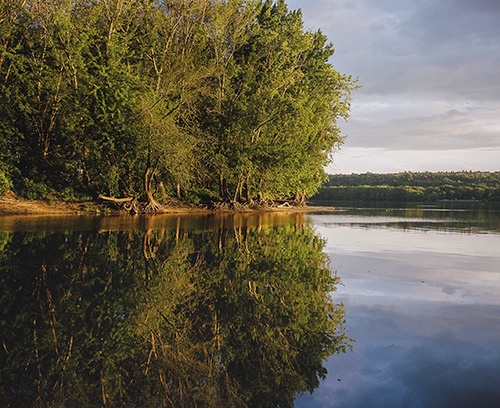 Photography by Chris Donovan
Photography by Chris Donovan
Giving Up Glyphosate
The forestry industry’s prized pesticide may be harming people and nature. Is it time to stop spraying?
As anyone who’s spent time in a forest knows, the quiet in even the most remote stretch of woods is never complete. Absent the rise and fall of human voices, the thrum of traffic from a nearby road, the distant tear of a passing plane, there are still sounds—the rustle of some small creature making its way furtively through the undergrowth, the drone of insects, the fluttering of leaves.
But in the Northern Ontario forests Troy Woodhouse first started exploring as a young man, a new kind of quiet has taken hold. In his early twenties, Woodhouse worked as a forester and moved from mixed boreal forests to monoculture plantations of spruce and pine. On his trips to assess the quality of timber prior to harvest, Woodhouse eventually felt the relaxation of being in the bush slip away. In its place, a feeling of unease crept in—it was eerily quiet, he says, as if he’d stepped into a ghost forest.
These stark transitions weren’t his first encounter with a changing ecosystem. As a teenager, Woodhouse, a member of Flying Post First Nation who grew up west of Timmins, Ontario, would go out in the bush to hunt moose. He had seen death inequitably distributed in the woods—dead or dying shrubs here, seemingly untouched conifers there. The inexplicable contrast struck Woodhouse as strange, and not only because these forests looked different: with the flutter and rustle of forest life silenced, the forests sounded different, too.
It was only after training to work in forestry that Woodhouse was able to identify the culprit: glyphosate, a herbicide used to suppress the growth of deciduous trees, like poplar and birch. This suppression, in turn, promotes the growth of the conifer plantations that are valuable to commercial forestry operations.
In the public conversation about forestry in Canada, much of the angst is sparked by concerns about clearcutting or the felling of old-growth trees. But forestry isn’t just a matter of what’s being taken out—it’s also about what’s being put in. And in ecosystems ranging from the boreal forests of Northern Ontario to the Acadian forest of New Brunswick—provinces where glyphosate spraying is reportedly happening at the highest levels in the country—community groups and Indigenous knowledge holders say the application of glyphosate is changing the soundtrack. Now, after decades of advocacy, work is underway to find new ways forward, before the sounds of the forest are lost for good.
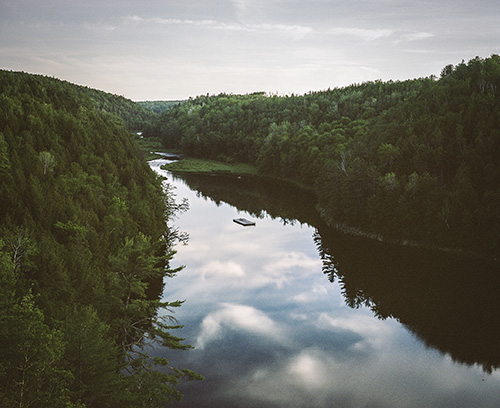
Forestry abounds with bland euphemisms. Terms like “even-aged management” and “low-retention harvesting” are often used to describe practices that are popularly understood through a blunter sobriquet: clearcutting. Estimates suggest that in 2019, 639,455 hectares of forest were clear-cut in Canada. Proponents of clearcutting say it replicates the natural processes that are part of the forest cycle, like fires and wind disturbances. But it’s likely an imperfect mirror, removing trees in a more homogenous and comprehensive way than through natural sources alone.
Following cutting on public land (which is carried out by forestry companies who’ve been issued licenses or timber supply agreements by the province or territory), harvesters are legally required to ensure the area is reforested. In the wide-open spaces of the ensuing microclimate, where shrubs and hardwoods thrive, this often means using glyphosate, making clearcutting and glyphosate use an unholy union from which it can seem impossible to escape.
Since its introduction to the market by Monsanto in the 1970s, glyphosate has achieved the kind of reach most chemical companies can only dream of. In Canadian forestry, where it’s by far the most used herbicide, it’s sprayed over tens of thousands of hectares of publicly owned forest every year. By blocking an important metabolic pathway, glyphosate prevents weeds, shrubs and deciduous trees from growing, and ultimately kills them.
Conifers are less vulnerable to glyphosate’s effects due to a protective coating on their leaves that makes it harder for the herbicide to penetrate their plant tissues. As a result, these trees are more likely to win the biological race that kicks off following the harvesting of a forest. With less competition from paper birch, raspberries and other fast-growing species, the pine and spruce seedlings planted after a clear-cut can grow more easily into the plantations useful for the forestry industry.
Because mammals and vertebrates don’t have the cellular pathway affected by glyphosate, some scientists and industry players have said that this makes the chemical relatively safe for people. In Canada, glyphosate is often spread by helicopters dropping clouds of the herbicide over remote forests. Perhaps for that reason, glyphosate application in forestry has attracted less attention than its use in agricultural and residential settings, where some studies have linked exposure to glyphosate to non-Hodgkin lymphoma.
In 2020, Bayer (which acquired Monsanto in 2018) agreed to pay more than $10 billion USD to settle US claims that the brand-name herbicide Roundup, of which glyphosate is the primary ingredient, causes cancer. Five years earlier, the World Health Organization’s International Agency for Research on Cancer declared that glyphosate is “probably carcinogenic to humans.”
Despite this fact, the US Environmental Protection Agency and Health Canada maintain that glyphosate is unlikely to pose a human cancer risk. Nonetheless, Bayer announced this past summer that it would replace its glyphosate-based landscaping products beginning in 2023, citing the risk of future litigation. For its part, Health Canada has committed to funding more research on the assessments of pesticides.
Many of the non-Hodgkin lymphoma cases where claimants have asserted or established a link to glyphosate involve people who’d been directly exposed for years, mixing and spraying Roundup as landscapers, farmers and homeowners, unaware of the potential dangers. In forestry, though, where glyphosate is most often rained from the sky, limiting the direct risk posed to those applying the chemical, the consequences of exposure have been even murkier. Except, that is, for those spending time in the woods.
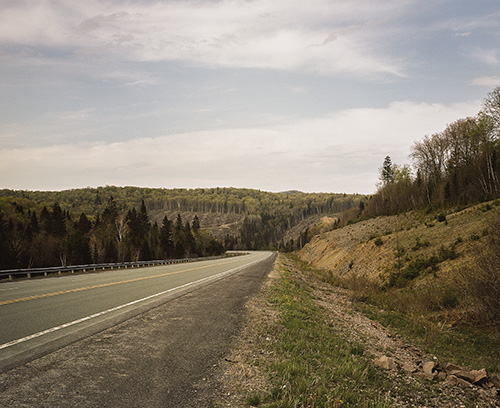
Nearly a decade ago, Susan Chiblow was passing through Mississauga First Nation, on the North Shore of Lake Huron, to check on an Anishinaabe Elder. By that point, Chiblow (who uses the pronoun “wiin”) had already come up against glyphosate. While working as the environmental coordinator for the Chiefs of Ontario, wiin had helped draft a 2008 resolution that identified chiefs’ opposition to spraying in their territories. They were concerned about the threat it posed to waters and plants, and called on the province to institute a ban on herbicide use in forestry.
But herbicide use continued. So it wasn’t altogether surprising when, several years later, Elders in the community Chiblow was passing through asked if wiin would help a group calling themselves the Traditional Ecological Knowledge (TEK) Elders bring about an end to glyphosate spraying in the Robinson-Huron Treaty territory, between Sault Ste. Marie and the Parry Sound region.
While in the bush, Sagamok Anishnawbek First Nation Elder Raymond Owl had seen signs posted warning of herbicide spraying, but that wasn’t all he’d observed. For years, Elders had also been noticing a concerning number of dead and dying plants. After talking to other Elders who’d seen similar warning signs and damage in the woods, and tracing the connection to glyphosate use, Owl formed the TEK Elders. Chiblow, who quickly became the group’s coordinator and de facto spokesperson, says Elders knew what was happening to plants would have consequences for other beings, including bears, birds and bees, as well.
Despite glyphosate’s widespread use, there have been gaps in the science on its long-term impact on forested ecosystems, perhaps because most of the research has been focused on its toxicity to people and large mammals, says Chiblow. But in recent years, studies have been published suggesting that glyphosate persists in the tissues of edible and medicinal plants for at least a year after spraying, though the effects of this on wildlife are unclear.
In some cases, these traces can last up to a dozen years, despite studies that have found glyphosate degrades quickly in most soils. Other research has found deformations in the reproductive structures of wildflowers one year after spraying, which could impact how attractive they are to pollinators, and affect foraging animals who rely on the plants for food and cover in open areas. Another study found that the presence of glyphosate in freshwater ecosystems affects the diversity of zooplankton. Researchers say the ecosystem-level consequences of this need further study.
Of course, much of this work confirmed what Elders were already saying. Throughout the 2010s, the TEK Elders carried out additional research of their own. They ran a water sampling project in areas along the North Shore of Lake Huron to establish a baseline against which future samples can be compared. They also made submissions to Environment Canada asserting the importance of traditional knowledge, and sent letters to the UN Special Rapporteur on toxics and human rights, as well as provincial and federal officials. The group cited not just ecological concerns over the use of glyphosate, but also violations of treaty rights to hunt, fish and gather plant medicines and berries in the territory. “It affects our way of life, affects our connections to the land, our governance systems, our law, it affects everything,” Chiblow says.
That broad impact has been top of mind for Tom Fox, newly minted councillor for Matachewan First Nation, in Treaty 9 territory southeast of Timmins. This year, as Fox was preparing to go into his first meeting with Ontario’s Ministry of Northern Development, Mines, Natural Resources and Forestry (NDMNRF) about spraying, he kept his expectations low. Despite years of advocacy by Indigenous groups, including his own council, little had changed.
Fox says when NDMNRF staff announced, with some fanfare, that there had been a 10 percent reduction in spray, he responded that it wasn’t enough. He asked staff if they’d let their kids play in the backyard after it was sprayed with glyphosate. “And right away, everybody’s like, ‘Oh, no, we can’t do that.’ Well that’s what you’re doing to our kids, because that’s our backyard. You spray it and then our kids go play in it,” he says. “Not only our kids, but I mean, us adults, we go in there too.”
Fox is focused on glyphosate for many reasons, including the loss of culture and tradition. He’s not alone; other councillors are helping to organize annual hunt camps to pass on traditional knowledge. This year, a member of the reserve donated a moose and showed youth how to skin and quarter it up. But without access to medicines, which Elders have told him are disappearing from the bush in areas that have been sprayed, Fox is worried that many of the avenues to pass traditional knowledge along to future generations will disappear.
In an emailed statement, the NDMNRF told Maisonneuve that it has no plans to phase out the use of herbicides in forestry, and that alternatives, such as manually removing competing species with brush saws, as is carried out in Quebec, remain expensive. (In Quebec, herbicides were banned in Crown forests twenty years ago, after concerns over their potential impact on public and environmental health fuelled multiple rounds of public consultation. Vegetation management in the province now involves manual tending and changes to seedling planting practices.)
The NDMNRF statement also noted that the department has safeguards in place, “including no spray buffer zones around sensitive areas, to minimize risks to people and the environment,” and that Health Canada’s most recent assessment determined that glyphosate “does not pose unacceptable risks to human health or the environment when used as directed.”
But Fox says though little has changed on the government side, something has shifted in the public reaction to glyphosate. In recent years, he’s seen concern about glyphosate expand beyond Indigenous communities, with small towns and community groups joining the conversation. And as the conversation around concerns becomes more fervent, so too does the one about solutions.
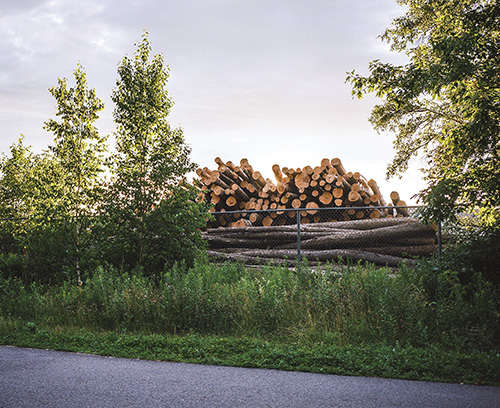
In 2011, a forestry company called Tembec and members of several Indigenous communities in Northern Ontario gathered in Timmins. They were there to identify and develop a strategy to apply alternatives to herbicides. It wasn’t the first time people had looked into vegetation management alternatives in Ontario. Researchers have investigated alternatives in other jurisdictions, including of the four-legged variety, with cattle and sheep proposed as agents of non-chemical weed control. They’ve also looked at manual clearing and a kind of fungi that attacks hardwood species.
In Tembec’s case, the company already had experience operating without herbicides in Quebec, following the provincial ban. But the Northern Ontario project was different, since it was guided by the concerns of the First Nations communities in whose territories Tembec (now called GreenFirst Forest Products) operates, such as Chapleau Cree and Missanabie Cree First Nations. After meeting with communities who unanimously identified herbicide spraying as their number one concern in forestry management, the Herbicide Alternatives Program (HAP) was born.
Since its inception, HAP has been operating in forests in Northern Ontario, trialling methods that could reduce herbicide use at several points along the process. These methods start even before harvest, identifying areas where soil and root disturbance should be minimized (reducing the spread of unwanted plants that would then be controlled with glyphosate). Then, during planting, the program has investigated the impact of changing the density and timing of planting, and whether planting larger seedlings could help planted trees outcompete other species.
When management of that competition is required, HAP sends employees into the bush armed with brush cutters, to remove trees and shrubs mechanically. Early results suggest that this brush cutting, alongside the use of larger seedlings, is helping planted trees survive. Meanwhile, the program has also been conducting surveys of plots, which informs whether or not an area can be excluded from spraying. This on-the-ground surveying can reduce herbicide use by helping foresters identify areas where alternatives are most likely to succeed. But it’s also triggered the start of a conceptual shift, moving glyphosate from the default option to the measure of last resort.
This has implications beyond HAP’s research areas, as the program has implemented steps that could be applied elsewhere in the region. Lark Ritchie, a Chapleau Cree First Nation member who was involved in HAP from 2012 until 2018 as co-chair of the steering team, says the program was meant to show what’s possible. “Our feelings were that by doing this, we would become a role model for other organizations in the industry to kind of understand what we were doing, and change their attitude from ‘you must be crazy’ to ‘we might be able to do something here.’”
Isabelle Allen is projects forester with Wahkohtowin Development, a development corporation owned by Chapleau Cree, Missanabie Cree and Brunswick House First Nations, which is a partner on the program. Ultimately, she says HAP is about a change in worldview—moving away from a formulaic approach to forestry to one that emphasizes a collaborative approach with Indigenous communities, for whom glyphosate use constitutes a fundamentally disrespectful relationship with the environment.
The way Allen sees it, the industry worldview looks to trees as a source of profit, whereas the Indigenous perspective emphasizes a reciprocal relationship with the ecosystem in its entirety. And insofar as HAP encourages foresters to be patient, to appreciate the interdependence of species in forest ecosystems, and to take concerns about chemical control seriously, it’s bringing those perspectives closer together, ushering in a less combative relationship between communities and industry, Allen says.
But the rapprochement isn’t complete; for some community members, HAP isn’t perfect. So far, it’s led to a reduction in herbicide use, including a 75 percent reduction in the Chapleau Crown Game Preserve in the program’s first phase, as well as an overall reduction of about 20 percent in the forests HAP is studying. The program isn’t over, and participants hope for further reductions. But Allen says a full halt to spraying remains tricky from an industry perspective, given that many competitors are still using herbicides—which are the most efficient and profitable option—even as elimination continues to be the goal for Indigenous communities.
“We’re signed on to this idea that we’re going to look for solutions together. But [communities’] goal is for sure zero,” says Allen. Scientific and technological advances could help move the needle, but the ultimate goal is policy change at a provincial and federal level, Allen says, both in strengthening the consultation and engagement requirements with Indigenous communities, and in addressing glyphosate use itself. Part of that change could come from activism in ecosystems far from the boreal forests of Northern Ontario.
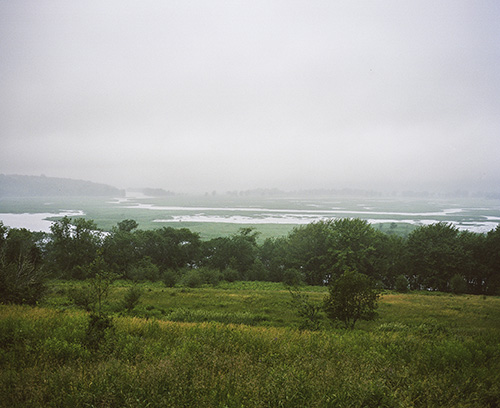
Matthiew Vienneau never set out to be an activist. A hunter, he’s used to spending time amid the trees in New Brunswick’s expansive forests, but for a long time, that’s where any overlap with anything “green” stopped. Still, he’d long been mistrustful of glyphosate. As a teenager, he lived five houses down from his grandparents’ farm. About twenty-five years ago, spray from the forest abutting their fields drifted onto one of the crops. Soon, the leaves turned yellow and the potatoes, when dug up, were blistered. Worried that the tubers were contaminated, Vienneau’s grandparents insisted on throwing the potatoes away.
Vienneau says J.D.Irving Ltd, the company that had been doing the spraying—and the largest forestry company, by far, in New Brunswick—compensated them for the loss of crop. The experience left Vienneau with a question: if glyphosate did that to plants, what was it doing to people?
J.D. Irving doesn’t only play a role in Vienneau’s story. The company exerts an outsize influence in the province, occupying a dominant position in industries ranging from forestry and food production to transportation. Other companies owned by the Irving family—one of the richest in Canada—are responsible for oil refining, media (they own most English-language newspapers in the province) and real estate, among other businesses. As a result, roughly one in twelve New Brunswickers is employed by the Irving family, and their companies have close ties to government. The premier of New Brunswick, Blaine Higgs, worked for Irving Oil for thirty-three years and has tapped former executives at Irving companies to provide advice to the province.
About two decades after Vienneau’s family’s brush with the Irvings, he ran into glyphosate again, in 2014. This time, he was planning a moose hunting trip in the forest. In New Brunswick, the moose hunting season for settlers is contained to less than a week in September. When Vienneau went to check his stand in preparation for the hunt, he saw moose tracks, but no signs of the animals themselves. After doing a bit of digging, Vienneau learned that the area had been sprayed with glyphosate.
In Ontario, the proportion of forest treated with glyphosate is a fraction of the forested land base, but it’s still the highest recorded, in terms of total hectares, in Canada. In 2018, the most recent year for which numbers are available, glyphosate was sprayed over nearly thirty-four thousand hectares of forest, mostly in Northern Ontario, representing about 40 percent of all glyphosate use in the country. But in New Brunswick, glyphosate is, in a way, even more dominant. In 2018, roughly fifteen thousand hectares of Crown forest were treated with glyphosate—nearly half Ontario’s total, in a province only 8 percent of Ontario’s size.
Moreover, glyphosate is helping to reshape the landscape. Much of the forest in New Brunswick is within the Acadian forest region, naturally made up not just of conifers, but also hardwoods such as sugar maple, yellow birch and American beech. It’s an ecoregion that the World Wildlife Fund has deemed endangered. Over time, researchers say clearcutting and conifer plantations have contributed to the transformation of the Acadian forest, a transition in which glyphosate plays a significant role.
For his part, motivated by concerns about the changes he’d seen in the woods, Vienneau launched a Facebook group after his relocated moose hunting trip, which eventually morphed into a group called Stop Spraying New Brunswick. The group started growing quickly soon after its inception, populated not only by environmentalists, but mostly by hunters and anglers who were as angry about glyphosate as Vienneau was. Eventually, overwhelmed by the public interest and the stacks of mail that the group’s petition was generating, Vienneau asked a Fredericton dentist named Caroline Lubbe-D’Arcy, who’d been active on other environmental issues, to take over the reins.
Initially, Lubbe-D’Arcy was concerned about a forestry plan the province had signed in 2014, which had augmented the amount of softwood in Crown forest allocated to industry, increasing harvesting by 21 percent. But in 2015, the CBC released a story, citing data that New Brunswick’s white-tailed deer hunt numbers were at one of the lowest levels ever recorded. In the story, a biologist working for the province pointed the finger at harsh winters. But many New Brunswickers had another idea; in the days after the story’s release, membership in the Stop Spraying New Brunswick Facebook group grew threefold.
“The shit was hitting the fan,” as Lubbe-D’Arcy puts it. A petition the group launched shortly afterwards quickly garnered tens of thousands of handwritten signatures, which members say makes it the largest petition in New Brunswick’s history.
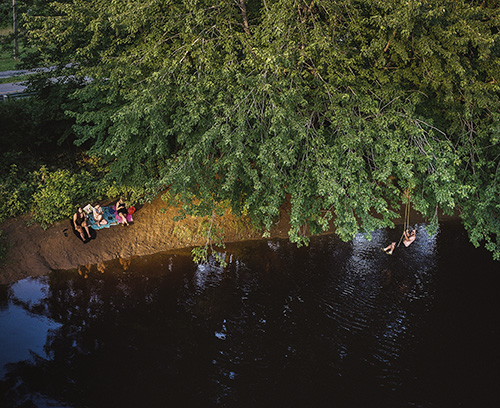
The concerns over glyphosate have particular resonance in New Brunswick, where the use of DDT in the twentieth century—particularly between 1952 and 1968, when at least 5.7 million kilograms of DDT were spread by aircraft to control for spruce budworm—led to devastatingly high mortality rates among Atlantic salmon in the Miramichi River. Those impacts served as part of the impetus for Rachel Carson’s 1962 book Silent Spring, which became a foundational text in the environmental movement.
By challenging claims by regulators and some scientists that DDT was safe, Carson’s book helped spur the 1972 ban on DDT in the US (though not in Canada, where DDT was not banned until 1985 and could be used until 1990). Following the publication of excerpts from Silent Spring, though, government officials and other scientists criticized Carson as being “misinformed,” a “bird-lover” and, predictably, a “spinster.” And as it turns out, criticizing glyphosate in New Brunswick hasn’t been straightforward either.
Since 2014, a number of researchers who’ve spoken out about New Brunswick’s forestry practices have faced consequences. An instructor and a former college director have been let go from the Maritime College of Forest Technology in Fredericton—wildlife biologist Rod Cumberland, who spoke out against glyphosate use, and Gerald Redmond, the colleague who defended him. Representatives of J.D. Irving and other forestry companies sit on the college’s board. (In Cumberland’s case, the college claims he was let go for harassing his students, a characterization Cumberland disputes.) According to the CBC, biology professor Marc-André Villard was dropped from a J.D Irving forestry committee and had research funding pulled by the company after raising concerns, including some regarding the impact of conifer plantations on biodiversity.
In response to a request for comment on glyphosate’s impact on forested ecosystems, the consequences for glyphosate critics, and the impact of a glyphosate ban on the profitability of the company’s forestry operations, a spokesperson for J.D.Irving sent a presentation in which the company’s director of research and development Andrew Willett said that the public’s concerns with glyphosate stem from “misinformation.”
“We can’t make public policy and we can’t make public investments on something Karen from Facebook said, or something we read on Google,” he told a legislative committee. “We rely on national and international regulators like Health Canada to provide us information on what is safe with the science.” In the same presentation, company co-CEO Jim Irving said a ban on glyphosate would have a dramatic impact on the business. “It would be disastrous,” he said.
A statement from the province’s Department of Natural Resources and Energy Development also said that despite research into alternatives, “there are no alternatives that match modern herbicides, such as glyphosate, in terms of general utility, effectiveness, reliability, low cost and documented environmental acceptability.”
But the effectiveness of alternatives is a matter of some debate. A long-term study in Oregon, which has compared stands sprayed with different degrees of herbicide, found that stands did regenerate without herbicides, although sprayed tracts grew 20 to 30 percent faster. Matthew Betts, a professor at Oregon State University who led the study, says the tradeoff for this speed is a “remarkable” decline in plant, pollinator and bird biodiversity.
That last category is a particular concern in New Brunswick. Betts has studied the decline of bird habitat in the Maritimes, as a consequence of intensive forestry practices that include glyphosate spraying. That research, which is still undergoing peer review, found that out of fifty-four common bird species in eastern Canadian forests, over 90 percent have experienced habitat declines between 2010 and 2020. Betts, who grew up planting trees in New Brunswick, knew the extent to which forests were changing. Nonetheless, he says the findings are alarming. “It’s a different story, when you really see the numbers on paper.”
Halting glyphosate could be one small part of reversing this decline, but it’s far from the only part. Betts says forestry practices writ large need to change in the Maritimes. At the same time, he says, “we need to respect and think about people who have their livelihoods based in the forest. It’s not them who are profiting massively from current practices.”
The question of the timber industry has made glyphosate use a particularly fraught conversation in New Brunswick, a small province where roughly ten thousand people are employed in forestry, including in places like Matthiew Vienneau’s hometown of Sainte-Anne-de-Kent, a region where he says he’s had less support than in other communities. He attributes this situation to the high proportion of the population that works for J.D.Irving.
In this polarized environment, information has become hard to trust. In late 2020, a full-page open letter appeared in several Irving-owned newspapers, stating that political parties’ support for a ban on glyphosate would be politically motivated if the policy doesn’t extend to “the use of all chemicals on all land types and all applications.” Two days later, the provincial Liberal opposition government said it would phase out glyphosate spraying on Crown land. (The party lost the provincial election two weeks later, and the commitment was dropped.) Other industry groups in the province have said concerns about glyphosate are not based in science, and that there is no substitute.
Meanwhile, advocates have said there hasn’t been enough research done on glyphosate’s impacts, and that existing research often has industry ties. This has, in turn, prompted grassroots efforts from citizens. Two thirteen-year-old girls in northern New Brunswick conducted a school science project looking at declines of herbivores in areas treated by glyphosate. They found significantly reduced rabbit, deer and moose tracks in areas sprayed with glyphosate. Members of the Wolastoqey Nation in New Brunswick led a testing program for the tissues and organs of moose brought in by hunters, which did not find glyphosate in the samples.
What isn’t in dispute is that for many communities, phasing out commercial forestry entirely is neither realistic nor desirable—and if forestry is going to continue, so too will a need to manage how the forest grows. Addressing this situation means tackling glyphosate use in the provinces that depend most heavily on it. And that means bridging the gap between communities and industry. On that, projects like the Herbicide Alternatives Program—though designed for the specific conditions of Northeastern Ontario—are nonetheless showing that a different way of thinking about herbicides is possible.
Yet as with Northern Ontario, policy change may be what advocates need to see significant progress. In April 2021, then-Green Fredericton MP Jenica Atwin introduced a private member’s bill to ban glyphosate nationwide, calling its use on New Brunswick’s forests and across the country a menace “to plant and wildlife biodiversity.” Atwin was responding to concerns from constituents, including Caroline Lubbe-D’Arcy and other members of Stop Spraying New Brunswick.
Because forestry is provincially regulated, the actions of provincial officials are important too. In the summer of 2021, New Brunswick’s standing committee on climate change and environmental stewardship held hearings on pesticide and herbicide use, including glyphosate spraying in forestry. The fact that these hearings happened at all is a sign that politicians are feeling the pressure, says Lubbe-D’Arcy, but she doesn’t believe the government is committed to change. Still, she thinks unflagging advocacy has shifted the conversation in the province and across the country.
Grassroots activism “is very ragtag in a way,” Lubbe-D’Arcy says. “But more and more people are becoming more smart about understanding how you can win this. And that is definitely something that we’ve been able to accomplish just by being out there and being recognizable.” Advocates in Northern Ontario hope that by bringing the issue to the forefront, they will underscore the need for provincial policy change there too.
Even consumers have a role to play in this. In the summer of 2021, pandemic-induced surges in the price of lumber sparked considerable angst across North America. Yet the expectation of cheap wood comes with considerable consequences—consequences that are playing out far from where most consumers live, in the forests of Ontario and New Brunswick. If more people decide they want to see those parts of the natural world preserved, the expectation of what the natural world can provide, and at what cost, will need to be recalibrated as well.
As for Troy Woodhouse, who spent his youth in the forests of Northern Ontario, he recently moved back to the area after some time away. He wanted to offer his three daughters, who are also members of Flying Post First Nation, a chance to get out on the land and connect with their roots. Finding alternatives to glyphosate is part of securing that future, he says. And yes, these alternatives will cost more money, and could complicate the goal, if the goal is managing forests to maximize the production of wood.
Yet there are other values at stake, too, and the issue with herbicides like glyphosate rests not just in their potential environmental impacts, but in how they shape the world into binaries: trees versus ecosystems, competitor species versus commercial value, economic strength versus ecological well-being. When all you have is a hammer, as the saying goes, everything looks like a nail.
And when measured against the potential losses—of birdsong, of the plants providing nourishment, of culture itself—the use of glyphosate creates a binary that may prove to be too stark of a tradeoff, after all.
Moira Donovan is an independent journalist and radio producer based on the east coast of Canada, with a body of work focused on the environment and climate change. Her work has appeared in the Christian Science Monitor, Vice, and the Walrus, and aired on CBC Radio. Follow her on Twitter @MoiraDonovan.





